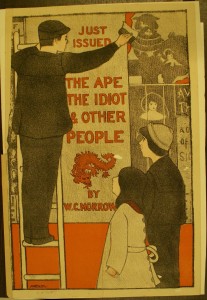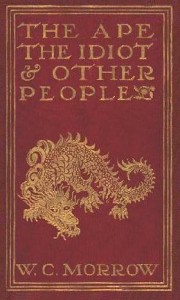
Anna Whelan Betts (1873-1959)|Just Issued: The Ape The Idiot and Other People, n.d.|Promotion poster for The Ape The Idiot and Other People by W. C. Morrow|(Philadelphia: J. B. Lippincott, 1897)|Collection of the Delaware Art Museum
In 1897 poster art was all the rage. Developed in the 1880s by the French artist and lithographer Jules Chéret (1836-1933), posters were art created in the service of advertising.* By 1892 the Century Magazine published the first American article on the new poster phenomena and Harper and Brothers hired the young illustrator Edward Penfield to produce original posters announcing the arrival of each new issue of Harper’s Monthly Magazine. In addition to the myriad of posters created to advertise new issues of various magazines, book publishers also took to having posters designed to promote their newest publications. The rapid expansion of the book market reflected an 1891 change in the international copyright laws that caused new American manuscripts to be comparable in cost to reprinting books from abroad. In order to satisfy the growing American market, publishers consequently sought manuscripts from American authors to publish.
Anna Whelan Betts (1873-1959) created this advertising poster to promote William Chambers Morrow’s (1854-1923) new book, of a collection of his stories, The Ape, the Idiot, and Other People published in 1897. Betts came from Philadelphia where she studied at the Pennsylvania Academy of the Fine Arts. After further study in Paris, Anna Betts returned home and took up her studies in 1896-97 with Howard Pyle in his newly formed illustration classes being offered at Drexel Institute, of Art, Science, and Industry in Philadelphia where he taught among other subjects, designs for posters.
In this poster Anna Betts not only creates the thing, but also shows how they were used. At the left of this picture, a man stands on a ladder with a paste brush in his right hand. He is smoothing down a poster announcing that the new book The Ape, the Idiot, and Other People has just been issued. He affixes this publication announcement to a wall over the top of other posters. Under his paste brush we can see the ripped edges of a poster of a stylishly decked out women wearing an enormous hat and a fur caplet. Below that image is another of a woman, this one seems to stand behind bars. Since only a small portion of the letters describing her plight are visible, we can only speculate as to her position.
Watching the man paste the poster to the wall are a mother and daughter walking along the street in front of the wall. They and the man seem so normal juxtaposed to the somewhat sensational poster images decorating the wall. Even more disconcerting is the poster’s fanciful red dragon hissing at the people as they pass by on the street. I would think the dragon hardly a likely lure for potential readers. The author, title, and image decoration, are taken directly from the book’s cover decoration

Anna Whelan Betts would go on to create many fine illustrations for a variety of books and magazines. Unlike those illustrations, poster images were more broadly drawn than illustrations within the books. So it is this two-color poster with its flattened, compacted space and the subtle elucidation of the characters’ clothing that keeps me coming back to Anna Betts’ work.
* For an overview of turn-of-the-century posters, see Joyce K. Schiller and Heather Campbell Coyle, Consuming Desires: Modern Marketing Posters, 1880-1918 (Wilmington, DE: Delaware Art Museum, 2005) https://www.delart.org/exhibitions/past/pdf/consuming_desires.pdf
** Ambrose Bierce, The Devil’s Dictionary (1911). Quote taken from https://www.fun-with-words.com/devil_s5.html
January 21, 2010
By Joyce K. Schiller, Curator, Rockwell Center for American Visual Studies
Norman Rockwell Museum






